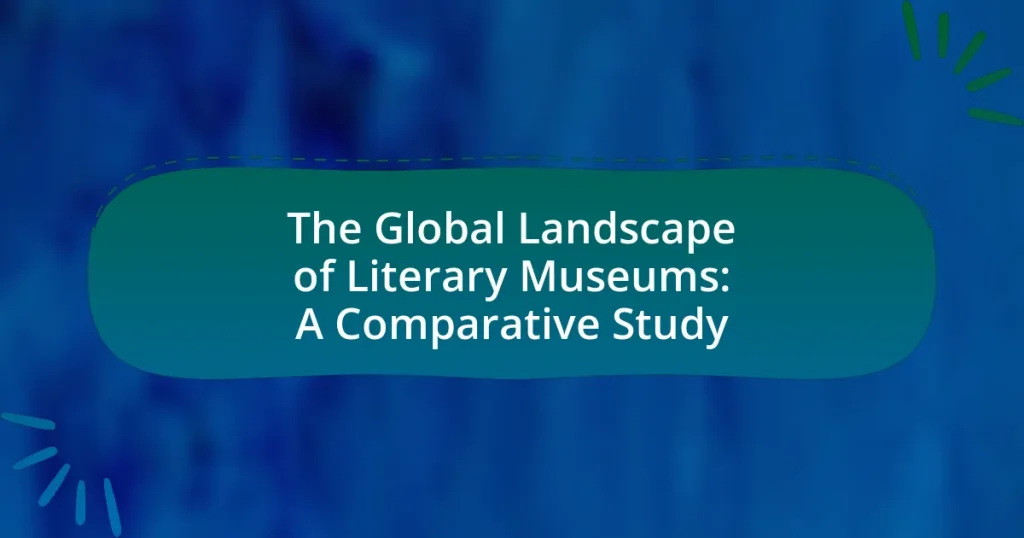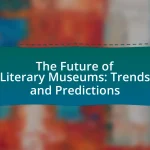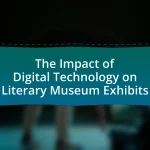Literary museums are specialized institutions dedicated to the preservation and interpretation of literary works and the lives of authors, playing a crucial role in global culture by promoting literacy and cultural heritage. This article explores the significance of literary museums, their unique features, and how they differ from traditional museums. It examines their role in preserving literary heritage, promoting literature, and engaging with local and global communities through educational programs and events. Additionally, the article addresses the challenges these museums face, including funding issues and the need for digital adaptation, while highlighting best practices for enhancing their effectiveness and sustainability.
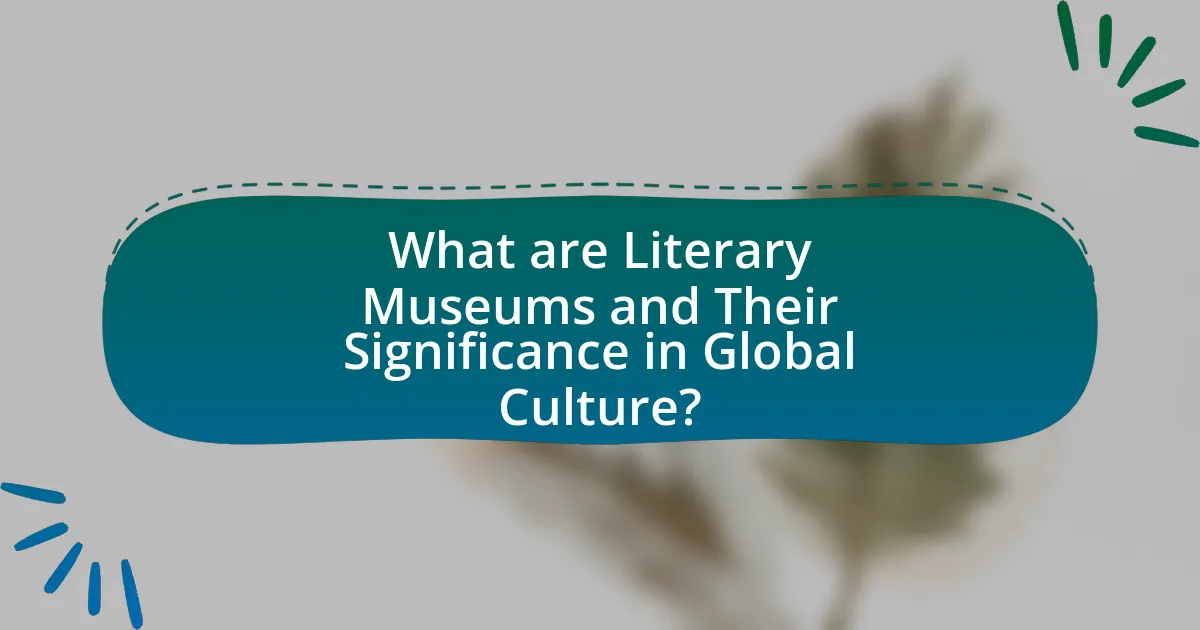
What are Literary Museums and Their Significance in Global Culture?
Literary museums are institutions dedicated to the preservation, exhibition, and interpretation of literary works, authors, and the cultural contexts in which they were created. These museums play a significant role in global culture by fostering appreciation for literature, promoting literacy, and providing insights into the lives and works of influential writers. For instance, the British Library in London houses original manuscripts from renowned authors, allowing visitors to engage directly with literary history. Additionally, literary museums often serve as cultural hubs, hosting events, workshops, and educational programs that encourage community involvement and cultural exchange. This engagement not only enhances public understanding of literature but also contributes to the preservation of cultural heritage, making literary museums vital to the global cultural landscape.
How do Literary Museums differ from traditional museums?
Literary museums differ from traditional museums primarily in their focus on literature and the lives of authors rather than on broader historical or artistic artifacts. While traditional museums often showcase a wide range of objects, including art, historical items, and cultural artifacts, literary museums specifically curate exhibits that celebrate literary works, authors, and the cultural contexts in which they were created. For example, the Ernest Hemingway Home and Museum in Key West, Florida, not only displays Hemingway’s personal belongings but also emphasizes his literary contributions and the environment that influenced his writing. This specialized focus allows literary museums to engage visitors with the narratives and themes of literature, providing a unique educational experience centered around the written word.
What unique features define a Literary Museum?
A Literary Museum is uniquely defined by its focus on the preservation and interpretation of literary heritage, including the works, lives, and contexts of authors. These museums often feature original manuscripts, personal artifacts, and interactive exhibits that engage visitors with the literary process and the cultural significance of literature. For example, the British Library houses over 150 million items, including manuscripts by famous authors, showcasing the depth of literary history. Additionally, Literary Museums frequently host readings, workshops, and educational programs that promote literary appreciation and scholarship, further distinguishing them from general museums.
Why are Literary Museums important for preserving literary heritage?
Literary museums are crucial for preserving literary heritage because they serve as dedicated spaces that collect, conserve, and interpret the works and lives of authors. These institutions not only safeguard original manuscripts, letters, and personal artifacts but also provide educational programs that promote understanding of literary history. For instance, the British Library houses over 170 million items, including significant literary works, which helps to maintain the cultural context of literature. By curating exhibitions and hosting events, literary museums foster appreciation for literary contributions and ensure that future generations can access and engage with this heritage.
What role do Literary Museums play in promoting literature?
Literary museums play a crucial role in promoting literature by preserving the legacy of authors and their works, thereby fostering public engagement with literary culture. These institutions provide educational programs, exhibitions, and events that highlight significant literary contributions, making literature accessible to diverse audiences. For instance, the British Library hosts exhibitions that showcase rare manuscripts and artifacts, attracting over 1.5 million visitors annually, which underscores the impact of literary museums in enhancing public interest in literature. Additionally, literary museums often collaborate with schools and universities to facilitate workshops and lectures, further integrating literature into educational curricula and community activities.
How do they engage with local and global communities?
Literary museums engage with local and global communities through educational programs, exhibitions, and collaborative projects. These institutions often host workshops, author talks, and community events that foster local participation and cultural exchange. For instance, many literary museums partner with schools and universities to promote literacy and creative writing, thereby enhancing community involvement. Additionally, they participate in international literary festivals and online platforms, which allows them to reach a broader audience and connect with global literary movements. This dual engagement not only enriches local culture but also positions these museums as vital players in the global literary landscape.
What educational programs do Literary Museums offer?
Literary Museums offer a variety of educational programs, including workshops, guided tours, lectures, and interactive exhibits. These programs aim to enhance visitors’ understanding of literary history, the works of specific authors, and the cultural context of literature. For instance, many museums provide workshops that allow participants to engage in creative writing or literary analysis, while guided tours often include discussions about significant artifacts and manuscripts. Additionally, lectures by authors, scholars, or curators further enrich the educational experience by providing expert insights into literary themes and movements.
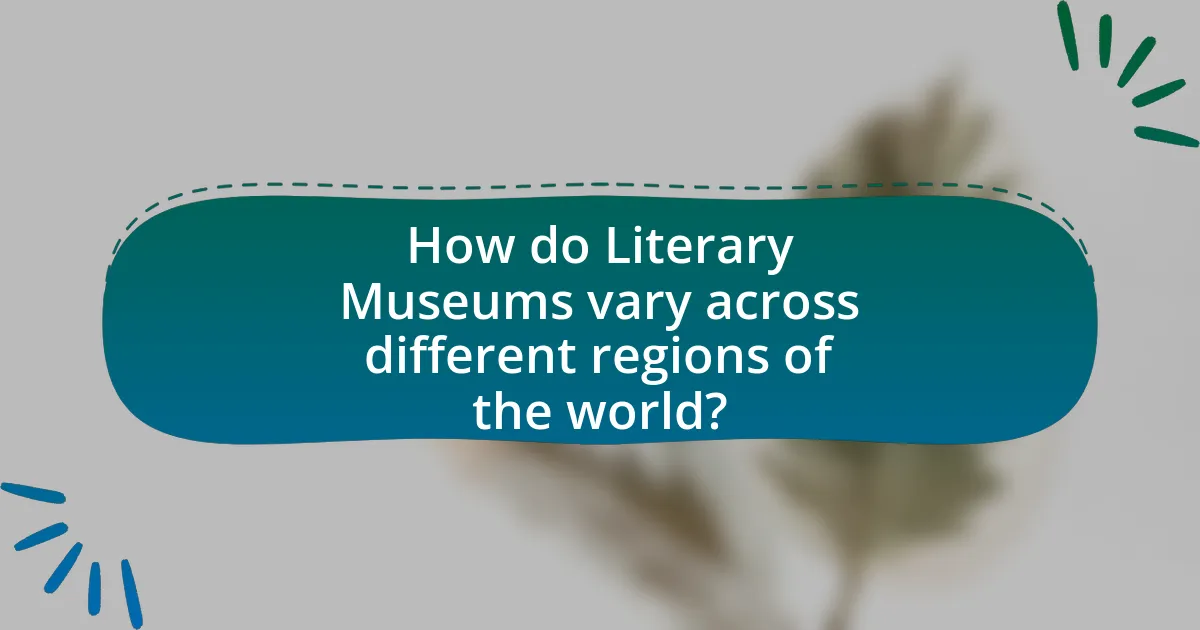
How do Literary Museums vary across different regions of the world?
Literary museums vary significantly across different regions of the world in terms of their focus, collections, and visitor engagement strategies. For instance, in Europe, literary museums often emphasize the historical context of authors, showcasing manuscripts and personal artifacts, as seen in the Charles Dickens Museum in London, which highlights the author’s life and works through original manuscripts and personal items. In contrast, literary museums in Asia, such as the Nanjing Museum of Literature in China, may focus on a broader cultural narrative, integrating literature with local history and art, thus reflecting regional storytelling traditions. Additionally, North American literary museums, like the Mark Twain House in Hartford, often incorporate interactive exhibits and educational programs aimed at engaging younger audiences, demonstrating a trend towards experiential learning. These variations illustrate how cultural, historical, and educational priorities shape the presentation and function of literary museums globally.
What are the key characteristics of Literary Museums in Europe?
Literary museums in Europe are characterized by their focus on the lives and works of authors, showcasing literary heritage through exhibitions, manuscripts, and personal artifacts. These museums often serve as cultural hubs, providing educational programs, literary events, and workshops that engage the public with literature. For instance, the Charles Dickens Museum in London features the author’s personal belongings and manuscripts, illustrating his life and impact on literature. Additionally, many European literary museums are housed in historic buildings, enhancing the visitor experience by connecting the physical space to the literary figures they celebrate.
Which notable Literary Museums exist in Europe and what do they showcase?
Notable literary museums in Europe include the British Museum in London, which showcases a vast collection of literary artifacts, including manuscripts and rare books; the Ernest Hemingway Home and Museum in Key West, Florida, which displays Hemingway’s personal belongings and manuscripts; and the Franz Kafka Museum in Prague, dedicated to the life and works of Kafka, featuring original manuscripts and photographs. Additionally, the Shakespeare Birthplace Trust in Stratford-upon-Avon offers insights into Shakespeare’s life through preserved sites and exhibits. Each of these museums provides a unique perspective on the authors’ contributions to literature and cultural history, supported by their extensive collections and historical significance.
How do European Literary Museums reflect the continent’s literary history?
European Literary Museums reflect the continent’s literary history by showcasing the lives and works of influential authors, preserving manuscripts, and providing insights into literary movements. These museums, such as the Charles Dickens Museum in London and the Franz Kafka Museum in Prague, highlight the cultural and historical contexts that shaped literary production in Europe. For instance, the museums often feature original manuscripts, personal artifacts, and interactive exhibits that illustrate the evolution of literary genres and styles across different regions. By curating collections that represent diverse literary traditions, these institutions serve as vital resources for understanding the interconnectedness of European literature and its impact on global literary discourse.
What distinguishes Literary Museums in North America?
Literary Museums in North America are distinguished by their focus on the cultural and historical context of local authors, often showcasing personal artifacts, manuscripts, and interactive exhibits that highlight the literary contributions of regional figures. For example, the Ernest Hemingway Home and Museum in Key West, Florida, preserves the author’s residence and offers insights into his life and works, while the Mark Twain House in Hartford, Connecticut, provides a comprehensive look at Twain’s literary legacy through guided tours and educational programs. These museums often emphasize community engagement and educational outreach, reflecting the diverse literary heritage of North America.
What themes and authors are predominantly featured in North American Literary Museums?
North American Literary Museums predominantly feature themes of identity, migration, and social justice, with significant representation of authors such as Mark Twain, Emily Dickinson, and Toni Morrison. These themes reflect the diverse cultural narratives and historical contexts of North America. For instance, Mark Twain’s works often explore themes of race and morality, while Toni Morrison’s literature addresses the complexities of African American identity and history. Literary museums in North America curate exhibits that highlight these authors and their contributions, showcasing artifacts, manuscripts, and personal items that provide insight into their lives and the societal issues they addressed.
How do these museums contribute to the understanding of American literature?
Museums dedicated to American literature enhance understanding by preserving and showcasing the works, lives, and contexts of influential authors. These institutions provide access to original manuscripts, personal artifacts, and curated exhibitions that illustrate the historical and cultural influences on American literary movements. For example, the Ernest Hemingway Home and Museum in Key West offers insights into Hemingway’s writing process and the environment that shaped his narratives, thereby deepening appreciation for his contributions to American literature. Additionally, educational programs and guided tours facilitate engagement with literary themes and historical contexts, fostering a more comprehensive understanding of the evolution of American literature.
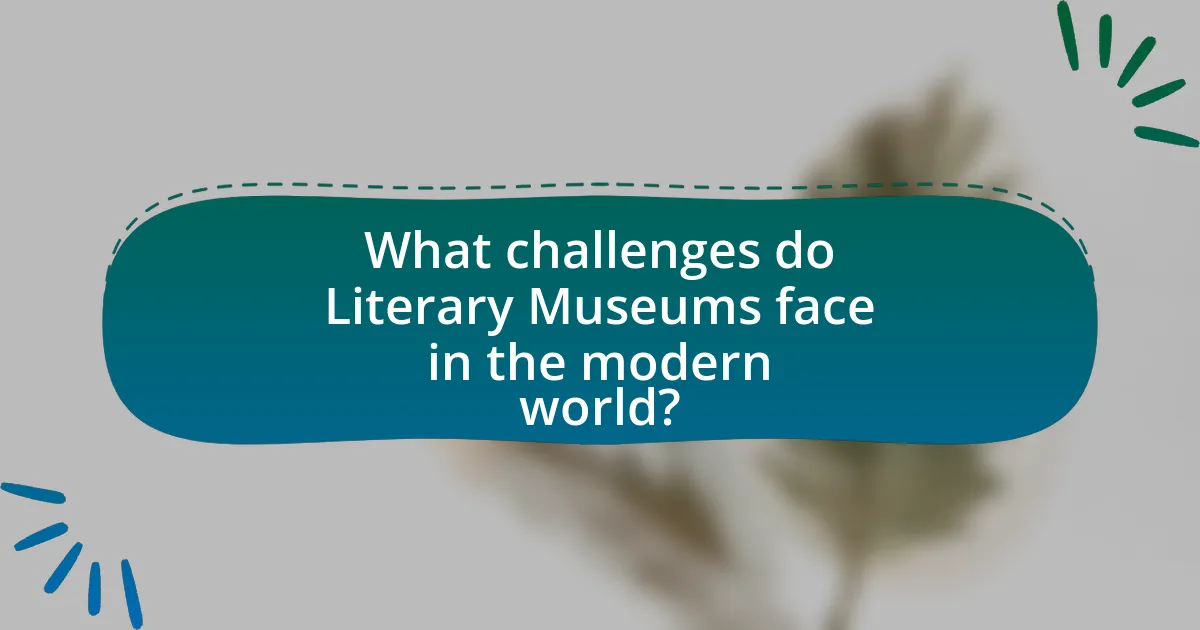
What challenges do Literary Museums face in the modern world?
Literary museums face several significant challenges in the modern world, including funding shortages, competition for visitor attention, and the need to adapt to digital advancements. Funding shortages hinder their ability to maintain exhibits and programs, as many rely on government grants and donations, which have become increasingly limited. Competition for visitor attention arises from various entertainment options, including digital media and other cultural institutions, making it essential for literary museums to innovate and engage audiences effectively. Additionally, the rise of digital technology necessitates that these museums integrate virtual experiences and online resources to remain relevant, as evidenced by the increasing number of virtual tours and online collections offered by institutions worldwide.
How are Literary Museums adapting to digital transformation?
Literary museums are adapting to digital transformation by implementing virtual exhibitions, enhancing online accessibility, and utilizing social media for engagement. For instance, many museums have developed interactive websites that allow users to explore collections and participate in virtual tours, thereby reaching a global audience. According to a report by the International Council of Museums, 70% of museums have increased their digital presence in response to the COVID-19 pandemic, highlighting the shift towards online platforms. Additionally, literary museums are leveraging digital storytelling techniques to create immersive experiences that resonate with younger audiences, ensuring relevance in a rapidly changing cultural landscape.
What technologies are being implemented to enhance visitor experiences?
Technologies being implemented to enhance visitor experiences in literary museums include augmented reality (AR), virtual reality (VR), interactive exhibits, and mobile applications. AR allows visitors to engage with literary works in immersive ways, such as visualizing scenes from books in real-time. VR provides fully immersive experiences that transport visitors into the settings of literary narratives. Interactive exhibits encourage participation, allowing visitors to explore themes and characters through hands-on activities. Mobile applications enhance visitor engagement by offering guided tours, additional content, and personalized experiences. These technologies have been shown to increase visitor satisfaction and educational outcomes, as evidenced by studies indicating that interactive and immersive experiences significantly boost visitor engagement and retention of information.
How do online resources impact the accessibility of Literary Museums?
Online resources significantly enhance the accessibility of literary museums by providing virtual tours, digital archives, and educational materials. These resources allow individuals who may not be able to visit in person, due to geographical, financial, or physical constraints, to engage with the museum’s offerings. For instance, the British Library offers online access to a vast collection of manuscripts and literary artifacts, enabling global audiences to explore its resources without physical travel. Additionally, many literary museums have developed interactive websites that include multimedia content, making the experience more engaging and informative. This shift towards digital accessibility has been supported by studies indicating that online engagement can increase visitor numbers and broaden the demographic reach of cultural institutions.
What funding and support challenges do Literary Museums encounter?
Literary museums encounter significant funding and support challenges primarily due to reliance on limited public funding and fluctuating private donations. Many literary museums operate under tight budgets, which restrict their ability to maintain exhibits, conduct educational programs, and engage in outreach activities. For instance, a study by the American Alliance of Museums indicates that nearly 60% of museums report financial instability, impacting their operational capacity. Additionally, competition for grants and sponsorships from both governmental and non-governmental organizations further complicates their financial sustainability. This reliance on inconsistent funding sources often leads to difficulties in long-term planning and program development, ultimately affecting the museums’ ability to fulfill their mission of promoting literary heritage.
How do economic factors influence the sustainability of Literary Museums?
Economic factors significantly influence the sustainability of Literary Museums by affecting their funding, visitor attendance, and operational costs. For instance, fluctuations in economic conditions can lead to reduced public and private funding, which directly impacts the resources available for maintenance and programming. According to a study by the American Alliance of Museums, 40% of museums reported a decline in revenue during economic downturns, leading to budget cuts that threaten their sustainability. Additionally, during periods of economic growth, increased disposable income can boost visitor numbers and ticket sales, enhancing financial stability. Thus, the interplay between economic conditions and funding sources is crucial for the ongoing viability of Literary Museums.
What strategies can Literary Museums employ to secure funding?
Literary Museums can employ diverse strategies to secure funding, including grant applications, partnerships with educational institutions, and community engagement initiatives. Grant applications to government bodies and private foundations are essential, as they provide significant financial support; for instance, the National Endowment for the Arts offers grants specifically for arts and cultural organizations. Partnerships with universities can enhance funding opportunities through collaborative projects and research grants, leveraging academic resources and expertise. Additionally, engaging the community through events, workshops, and membership programs can foster local support and generate revenue, as seen in successful literary museums that have increased visitor numbers and donations through active community involvement.
What best practices can enhance the effectiveness of Literary Museums?
To enhance the effectiveness of Literary Museums, implementing interactive exhibits is crucial. Interactive exhibits engage visitors more deeply, fostering a personal connection to the literature and authors represented. Research indicates that museums with hands-on experiences see a 30% increase in visitor satisfaction and retention rates. Additionally, integrating technology, such as augmented reality and mobile applications, can provide immersive storytelling experiences, making literature more accessible and engaging. A study by the American Alliance of Museums found that 70% of visitors prefer museums that utilize technology to enhance their experience. Furthermore, collaborating with local schools and literary organizations can expand outreach and educational programs, increasing community involvement and awareness. These practices collectively contribute to a more dynamic and impactful Literary Museum experience.
